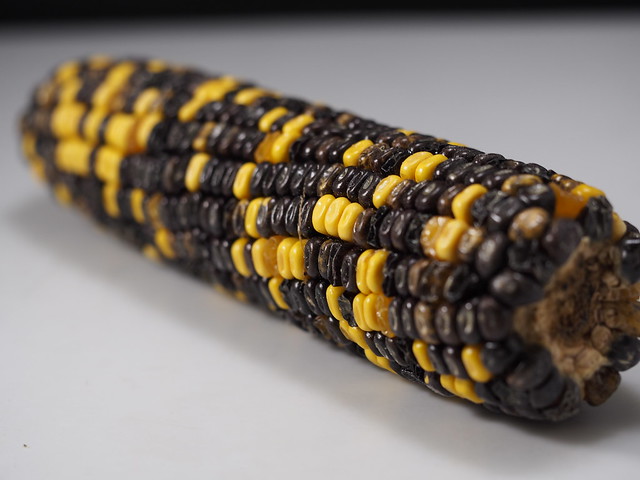Table of Contents
Corn Coloration in an F2 Population
Overview
In this activity, you will study the genetics of kernel color in corn. A corn cob contains hundreds of kernels. Each kernel is a seed that represents an individual organism. In the cob, we can easily see kernel color (either yellow or purple) as a phenotype.

Materials
Each lab group will need the following materials:
- 1 F2 corn cob
- paper
- pen
- calculator
Method
- Retrieve an F2 corn cob from the bucket.
- Count a total of 100 kernels.
- Tally the number of yellow kernels within that 100 (in the dried state, anything yellow or honey colored counts as yellow).
- Tally the number of purple kernels within that 100 (in the dried state, purple colored kernels may appear brown).
- Ignore any speckled kernels that may have yellow and purple within them.
- Share your counts with the other lab groups.
Analysis
Work with your lab group to answer the following questions:
- Based on your data for the F2 generation, which phenotype appears to be dominant? What evidence supports that claim?
- Based on your data for the F2 generation, which phenotype appears to be recessive? What evidence supports that claim?
- Create a Punnett square to illustrate the expected number of each color in a simple dominant:recessive paradigm.
Kernel Coloration and Texture in an F2 Population
Overview
In this activity, you will investigate two traits of corn: kernel color and kernel texture. You will use the same corn that was used in the previous activity.
Materials
Each lab group will need the following materials:
- 1 F2 corn cob
- paper
- pen
- calculator
Method
- Retrieve a dihybrid F2 corn cob from the bucket.
- Count a total of 200 kernels
- Tally the number of yellow kernels that are rounded and smooth in texture.
- Tally the number of yellow kernels that are shriveled and wrinkly in texture (honey colored).
- Tally the number of purple kernels within that rounded and smooth in texture.
- Tally the number of purple kernels within that are shriveled and wrinkly in texture.
- Ignore any speckled kernels that may have yellow and purple within them.
- Share your counts with the other lab groups.

Analysis
Work with your lab group to answer the following questions:
- Is there a dominant texture (rounded or wrinkled)?
- Which is dominant, if there is?
- Is there a color that always pairs with a texture or do these characteristics assort independently?
- Create a Punnett square to illustrate the expected number of each color/texture combination in a simple dominant:recessive paradigm.





